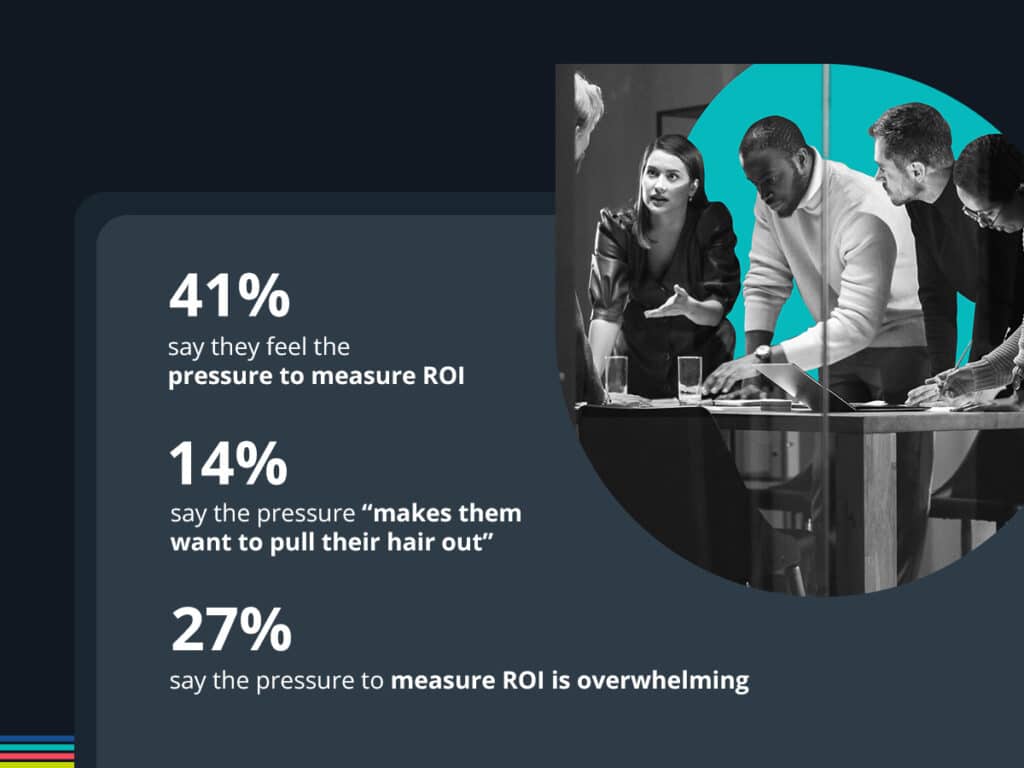Pressure has been building around proving ROI.
Sure, it’s always been there to some extent, but that pressure has recently increased, according to B2B marketers. And many say that while expectations for ROI are increasing, their budgets are not.
Hardly seems fair, right?
A recent survey of marketers by MarTech.org found that, of those surveyed:

An effective way to improve ROI is focusing on strategic changes in your nurture campaigns to build stronger pipeline. Want a few ideas for getting started? We’ve shared our favorite five lead nurturing examples and strategies.
Audit existing email nurture campaigns for performance
Do you have engagement programs scheduled to kick off after a prospect attends a webinar, downloads content, or takes other actions with your brand?
If so, that’s a great first step. The second is figuring out how to make those lead nurturing campaigns work harder.
Begin by checking your open rates.
For example, we did a complete audit of our nurture sequences last year and found the open rate was around 25%. That’s a decent performance, but there was an opportunity to improve.
Our internal guru, Kelsey Yen, revamped our nurture campaigns, and our open rate jumped from 25% to 48%. Our clickthrough rates increased from 1.32% to 17.93%.
Not bad, right?
Here’s a quick rundown of what Kelsey did:
- Inventoried what we had. She looked at the current program metrics to determine which messaging worked and which didn’t.
- Aligned with intent and the buyer’s journey. As she looked through the data, she also figured out which messaging performed best with our target ICP but also aligned with where a person was in their journey (top of funnel, middle of funnel, or bottom of funnel).
- Created streams based on how people entered the database. She accounted for how each person entered our database. Did they download an eBook, attend a webinar, or do something else? The goal was to capture the data to ensure they were tagged appropriately to get into the correct nurture sequence.
Of course, this is a quick summary of the process. We published the full details here, if you want to check them out and apply the strategies to your own nurture campaigns.

Focus on nurturing your silent prospects
Obviously, you want to focus on the prospects taking action and proactively moving through their buyer’s journey, but what about the prospects who won’t budge?
Focusing on nonaction prospects is an underrated strategy, and here’s why: It’s not always about the actions prospects take; sometimes it’s about the actions they don’t take.
Imagine a known prospect visiting your product page but not performing the desired action. And when we say “known,” we mean they’ve interacted with your brand in the past, so you have their email address (courtesy of your marketing automation platform).
You can use that nonaction for a trigger email and to kick off a campaign.
Maybe this means sending the prospect an appropriate eBook based on their interests or sending a related webinar replay. The goal is to keep the conversation going. You want to turn that nonaction prospect into an engaged prospect.
Go deeper with your existing customers through lead nurturing
Growing customer lifetime value (CLV) isn’t a new concept to marketers.
Yet only 25% of marketers rank customer lifetime value (CLV) among their top five marketing metrics.
And here’s something else to consider: Research shows that while most businesses make sales to between 5% and 20% of new customers, they close deals with 60% to 70% of existing customers.
Email nurture campaigns can help you go deeper with your existing customers and grow your CLV. Here’s a few ideas:
- Segmented product recommendations. Use customer data to segment your audience based on their buying history and current behavior. Then send targeted content to them based on the data, to encourage related purchases.
- Design reengagement campaigns. Target inactive or dormant customers by sending personalized messages with exclusive content, limited-time offers, or other premiums based on past interests.
- Ask for feedback. As you work to nurture leads, consider asking for input about your products or services. For example, let’s say you offer a marketing automation solution. You might ask: what do you wish you could do when creating nurture campaigns that you currently can’t? Maybe the customer wants help coming up with good subject lines because it’s time-consuming (by the way, we actually created that feature). You can now use that feedback during product iteration and updates.
These three areas are excellent opportunities to showcase additional product or content recommendations and fill the pipeline with new opportunities.

Design nurture campaigns based on lead scoring
A Gartner study found that businesses using lead scoring experienced a 77% increase in ROI with lead generation.
The research also revealed that 70% of leads are lost due to inadequate follow-up.
Lead scoring allows you to master the follow-up.
Lead scoring can trigger emails about scheduling a call or booking a demo for your “hot leads.” For example, Starshot’s team uses Act-On’s precision lead scoring capability to automate the process, enabling them to focus on marketing-identified “hot” opportunities and move leads through the pipeline faster and more strategically.
A warm lead might receive relevant content such as a case study, a white paper, or other educational content. And a cold lead might trickle into a nurture campaign focused on reengagement. You can then offer them highly personalized content based on where they are in their journey.
Launch an educational nurture campaign
Have you ever purchased a product, got excited about using it, and immediately run into frustrating roadblocks?
Yeah, us too!
When this happens with one of your customers, you run the risk of churn and the loss of future revenue opportunities.
You can combat this challenge with educational nurture campaigns.
Design your campaign with common customer challenges in mind.
If you aren’t clear on the challenges, talk with your customer service and sales folks. They’ll have plenty of ideas! Then create educational content, blog posts, eBooks, or webinars to address those challenges and build loyalty and satisfaction.
Bigger budgets would be nice, but in the meantime …
The rest of us are just working smarter. And part of that strategy can include nurture campaigns designed to build a stronger pipeline.
As you work to achieve that, consider that lead nurturing software, such as marketing automation, helps you get there faster and easily show ROI.
